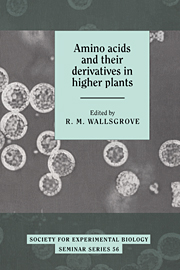Book contents
- Frontmatter
- Contents
- List of contributors
- Preface
- Glutamine synthetase in higher plants: molecular biology meets plant physiology
- Interactions of nitrogen and carbon metabolism: implications of PEP carboxylase and isocitrate dehydrogenase
- The genetics of aspartate derived amino acids in higher plants
- Oxidation of 1-aminocyclopropane-1-carboxylic acid (ACC) in the generation of ethylene by plants
- Regulation of carbon flow through the branched chain amino acid biosynthetic pathway
- Amino acid metabolism and protein deposition in the endosperm of wheat: synthesis of proline via ornithine
- The glycine decarboxylase complex in higher plant mitochondria: structure, function and biogenesis
- Glycine and serine synthesis in non-photosynthetic tissues
- Biogenesis of N-heterocydic amino acids by plants: mechanisms of biological significance
- Toxicity of non-protein amino acids from plants
- Processes involved in glutathione metabolism
- Betaines in higher plants – biosynthesis and role in stress metabolism
- Metabolism and function of polyamines during osmotically induced senescence in oat leaves and protoplasts
- Biosynthesis of cyanogenic glucosides. Elucidation of the pathway and characterization of the cytochromes P-450 involved
- The biosynthesis of glucosinolates in Brassicas
- Biochemical genetics of aliphatic glucosinolates in Brassica and Arabidopsis
- Index
Biosynthesis of cyanogenic glucosides. Elucidation of the pathway and characterization of the cytochromes P-450 involved
Published online by Cambridge University Press: 09 April 2010
- Frontmatter
- Contents
- List of contributors
- Preface
- Glutamine synthetase in higher plants: molecular biology meets plant physiology
- Interactions of nitrogen and carbon metabolism: implications of PEP carboxylase and isocitrate dehydrogenase
- The genetics of aspartate derived amino acids in higher plants
- Oxidation of 1-aminocyclopropane-1-carboxylic acid (ACC) in the generation of ethylene by plants
- Regulation of carbon flow through the branched chain amino acid biosynthetic pathway
- Amino acid metabolism and protein deposition in the endosperm of wheat: synthesis of proline via ornithine
- The glycine decarboxylase complex in higher plant mitochondria: structure, function and biogenesis
- Glycine and serine synthesis in non-photosynthetic tissues
- Biogenesis of N-heterocydic amino acids by plants: mechanisms of biological significance
- Toxicity of non-protein amino acids from plants
- Processes involved in glutathione metabolism
- Betaines in higher plants – biosynthesis and role in stress metabolism
- Metabolism and function of polyamines during osmotically induced senescence in oat leaves and protoplasts
- Biosynthesis of cyanogenic glucosides. Elucidation of the pathway and characterization of the cytochromes P-450 involved
- The biosynthesis of glucosinolates in Brassicas
- Biochemical genetics of aliphatic glucosinolates in Brassica and Arabidopsis
- Index
Summary
Introduction
Cyanogenic glucosides are secondary plant products which, upon hydrolysis, release HCN. Cyanogenic glucosides are found in more than 2000 plant species, including the agriculturally important sorghum and cassava. Insufficient removal of the cyanogenic glucosides present in the cassava tubers constitutes a potential health hazard for the millions of people who are dependent on these tubers as their staple food. The presence of cyanogenic glucosides in cassava tubers have been shown to improve their resistance against the cassava root borer (Bellotti & Arias, 1993). However, in other cyanogenic plants, the cyanide released may be more harmful to the host plant than to the pest organism. This is the case in the cyanogenic rubber tree (Hevea brasiliensis), where elevated amounts of cyanogenic glucosides result in increased sensitivity to attack by the fungus Microcyclus ulei (Lieberei, 1986). Similarly, the presence of the cyanogenic glucoside epi-heterodendrin in the epidermal cells of barley seedlings is correlated with an increased sensitivity to the mildew fungus Erysiphe graminis Pourmohseni & Ibenthal, 1991. In these cases, the HCN released upon infection is impairing the plant defence responses, either by inhibiting the synthesis of phytoalexins or by inhibiting polyphenol oxidases (Lieberei et al. 1989). The presence of even minor amounts of epi-heterodendrin in barley malt causes a problem in the brewing industry (Cook et al. 1990). During the distilling process cyanide is liberated, which results in the formation of the carcinogenic ethylcarbamate, formed from cyanide and ethanol.
- Type
- Chapter
- Information
- Amino Acids and their Derivatives in Higher Plants , pp. 227 - 242Publisher: Cambridge University PressPrint publication year: 1995
- 7
- Cited by



